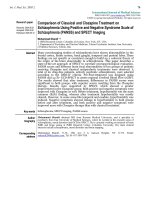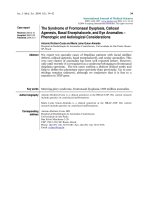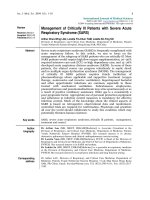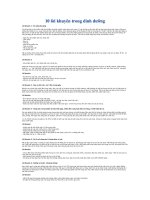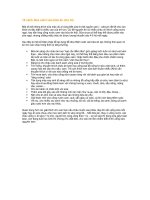10 irritable bowel syndrome v01
Bạn đang xem bản rút gọn của tài liệu. Xem và tải ngay bản đầy đủ của tài liệu tại đây (1.72 MB, 40 trang )
by
Dr TRẦN NGỌC ÁNH
Hà Nội Medical University
Objectives
1.Recognize the typical
clinical presentation for
IBS
2.Describe an appropriate
diagnostic plan and ROME
III
3.Prescribe an appropriate
therapeutic regimens
IBS- Dr Trần Ngọc Ánh
GENERAL CONSIDERATIONS
IBS- a functional bowel disorder : abdominal pain,
discomfort, altered bowel habits, absence of detectable
structural abnormalities
IBS-other functional disordes: fibromyalgia, headech,
backache, genitourinary symptoms
IBS- Dr Trần Ngọc Ánh
GENERAL CONSIDERATIONS
Diagnosis: Clinical presentation
10-20% adult, adolescents: symptoms of IBS
W/M:2-3; 80% Severe in women
IBS- Dr Trần Ngọc Ánh
IBS- Dr Trần Ngọc Ánh
PATHOPHYSIOLOGY
IBS- Dr Trần Ngọc Ánh
IBS
Genetics
Abnormal GUT
motility
Visceral
hypersensitivity
PATHOPHYSIOLOGY
IBS- Dr Trần Ngọc Ánh
PATHOPHYSIOLOGY
Psychosocial factor
Heightened pain sensitivity to visceral
stimulation of the brain gut axis
Fibromyalgia (49% have IBS)
Chronic fatigues syndrome (51%)
Chronic pelvic pain (50%)
JMTs (64%)
Post infections causes: luminal irritation small
bowel bacteries over growth, gas, food allergy
IBS- Dr Trần Ngọc Ánh
CLINICAL FEATURES
1.Abdominal pain
-Localition: 25% hypogastrium, 20% rightside, 20%
left side, 10% epigastric
-Episodic and crampy
-Exacerbated by eating or emotional stress
Improved by passage of flatus or stools
Worsening during the premenstrual and menstrual
phases
IBS- Dr Trần Ngọc Ánh
CLINICAL FEATURES
2.Altered Bowel Habit
-Most consistent clinical feature
-Constipation alternaty with diarrhea, usually with
onve of these symptoms predominantly
-Constipations: episodic, continous and
increasingly intractable to laxative . Interrupted
with brief periods of diarrhea
-Diarrhea
Smll volumes of loose stools (<200mL). Not
bleeding. Maybe: passage of large amount mucus
IBS- Dr Trần Ngọc Ánh
CLINICAL FEATURES
Aggraved by emotional stress or eating
Malabsortion or weight loss: not occur
3,Gas and Flatulence
-Abdominal distension, increased belching or
flatulence (Increased gas)-Quantitative
measurement reveal: no more than a normal
amount of intestinal gas
-Impaired transit and tolerance of intestinal gas
loads
-Reflux gas from the distal to the more proximal
intestine belching
IBS- Dr Trần Ngọc Ánh
CLINICAL FEATURES
4,Upper Gastrointestinla symptoms
-Dyspepsia, heartburn, nausea, vomiting: 31.7%
Dyspepsia have IBS (7.9% Non dyspepsia have IBS)
IBS 55.6% have dyspepsia
IBS- Dr Trần Ngọc Ánh
CLINICAL FEATURES
Typ of IBS
Typ of IBS
IBS- Dr Trần Ngọc Ánh
75% change subtyps, 29% swith between IBS-C, IBS-D over 1 years
IBS alternating 39%
IBS diarhea 27%
IBS-
constipationm34%
IBS- Dr Trần Ngọc Ánh
CLINICAL FEATURES
IBS- Dr Trần Ngọc Ánh
Spectrum of severity in IBS
Clinical
features
Mild
Moderate
Severe
Prevalence
70%
25%
55
Correlation
with
Physiology
+++
++
+
Symptoms
0
+
+++
Psychosocial
difficulties
0
+
+++
Health
care
issues
+
++
+++
IBS- Dr Trần Ngọc Ánh
LABORATORY FINDINGS
Complete blood count
Sigmoidoscopy
Stool specimens
Air contrast barium enema
Colonoscopy
Exclude lactase deficiency
Hydrogen breath test
Evaluation after 3 weeks lactase free diet
Exclude celiac sprue (Serology test)
GI radiography, Gastroscopy, Ultrasonography
IBS- Dr Trần Ngọc Ánh
APPROACH TO THE PATIENT
Careful history, physical examination, establish
the diagnosis
Recurrence of lowel abdominal pain with altered
bowel habits over a period of time without
progressive deterioration
Exclude
-Disorder for the first time in old age
-Persistent diarhea after a 48 h
-Nocturnal diarrhea, steatose
IBS- Dr Trần Ngọc Ánh
APPROACH TO THE PATIENT
Young patients
• Complete blood
count
• Sigmoidoscopy
• Stool specimens
>40 years
• Air contrast barium
enema
• Colonoscopy
If patient have
• Sedimentation rate
• Leucocyte or blood
in stool
• Stool volume
>200ml
• OTHER
DIAGNOSTIC
IBS- Dr Trần Ngọc Ánh
APPROACH TO THE PATIENT
Diagnostic criteria for irritable bowel syndrome
ROME
IBS- Dr Trần Ngọc Ánh
Recurrent abdominal pain or discomfort at least 3 days
per month in the last 3 months asscociated with 2 or 3
mor of the following
Improvement
with
defecation
Onset
asscociated
with a change
in frequency of
stool
Onset
asscociated
with a change
in form
(appearance of
stool)
TREATMENT
DIETARY
ALTERATIONS
STOOL BULKING
AGENTS
ANTISPASMODIC ANTIDIARRHEAL
ANTIDEPRESSANT
DRUG
ANTIFLATULENCE
THERAPY
SEROTONIN
RECEPTION
AGONIST,
ANTAGONISTS
CHLORIDE
CHANNEL
ACTIVATION
IBS- Dr Trần Ngọc Ánh
TREATEMENT
1.Patient counseling and dietary alterations
-Chronic and benign
-Avoid obvious food precipatant
-A meticulous dietary history may reveal substances
(Coffe, disaccharides, legumes, carbbage) aggravate
symptoms
-Excessive fructose, artificiel sweteners (sorbitol,
manitol) may cause diarrhea, bloating, crampy, or
flatulence
IBS- Dr Trần Ngọc Ánh
TREATEMENT
Good food for IBS
IBS-D: low fiber
exclusion diet
IBS-C: Low fiber plus
or minus laxtive
IBS-C no bloating:
high fiber diet plus or
minus laxative
IBS- Dr Trần Ngọc Ánh
TREATEMENT
Avoid food in IBS
-Alcohol,
caffein related drink
Non citrus drink,
herbalte
-Avoid all: milk
butter, yoghurt →soya
subtitutes
IBS- Dr Trần Ngọc Ánh
TREATEMENT
Avoid food in IBS:
Processed meats, burges,
sausages
IBS- Dr Trần Ngọc Ánh


